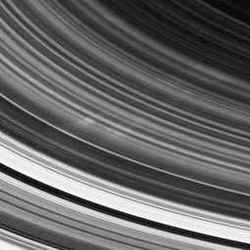
An image showing faint, narrow spokes in the outer B ring. Image credit: NASA/JPL/SSI Click to enlarge
Scientists are celebrating the first Cassini spacecraft sighting of spokes, the ghostly radial markings discovered in Saturn’s rings by NASA’s Voyager spacecraft 25 years ago.
A sequence of images taken on the side of the rings not illuminated by the sun has captured a few faint, narrow spokes in the outer B ring, about 3,500 kilometers long and about 100 kilometers wide (2,200 miles by 60 miles).
The images can be seen at: http://www.nasa.gov/cassini, http://saturn.jpl.nasa.gov and http://ciclops.org .
Previously, scientists believed the visibility of spokes depended on the elevation of the sun above the rings. The less sunlight, the more visible the spokes. For this reason, they weren’t expecting to see spokes until later in the mission when the sun angle will be low.
In Voyager images from 25 years ago, the spokes appeared dark when seen at low sun angles and bright when seen at high sun angles. This behavior indicated that they were comprised of extremely small icy particles. Since Voyager days, spokes had been seen in images taken by NASA’s Hubble Space Telescope. The new Cassini images were taken at very high sun angles, where small particles can brighten substantially, making them more visible.
Determining the timing in the appearance of spokes will be of intense interest and will require monitoring spoke activity from a variety of geometries over several years. “Cassini has found that the Saturn Kilometric Radiation period has changed since Voyager, which though hard to believe, may mean that the rotation of Saturn’s interior has changed,” said Dr. Carolyn Porco, Cassini imaging team leader at the Space Science Institute in Boulder, Colo., and one of the first individuals to study spokes in Voyager images. “That would be a finding of enormous consequence, so we’ll be looking very closely to see if the frequency of spoke activity has changed too.”
Porco’s analysis of spokes in the early 1980s found that these narrow arrangements of small particles came and went with a period equal to that of the powerful bursts of radio waves, called Saturn Kilometric Radiation, discovered by Voyager and coming from Saturn’s magnetic field. This association indicated that spokes were a phenomenon involving electromagnetic effects due to Saturn’s magnetic field.
There is no commonly accepted theory for the creation of spokes. Some ideas suggest that spokes result from meteoroid impacts onto the rings; others suggest that they are created by instability in Saturn’s magnetic field, which surrounds the planet, near the rings. Whatever the cause, imaging team members will study the new spoke images and maintain their vigil for additional spoke sightings.
Cassini also completed a flyby of Saturn’s moon Titan on Wednesday, Sept. 7. During that flyby, one of two solid-state recorders on board the spacecraft failed to record science data as planned. The spacecraft team is troubleshooting the cause of the anomaly, and early indications point to a software problem that would be correctable with no long-term impacts. About half of the planned science data was received.
This was Cassini’s eighth flyby out of 45 Titan flybys planned in the nominal four-year tour.
The Cassini-Huygens mission is a cooperative project of NASA, the European Space Agency and the Italian Space Agency. The Jet Propulsion Laboratory, a division of the California Institute of Technology in Pasadena, manages the Cassini-Huygens mission for NASA’s Science Mission Directorate, Washington. The Cassini orbiter and its two onboard cameras were designed, developed and assembled at JPL. The imaging operations center is based at the Space Science Institute in Boulder, Colo.
Original Source: NASA/JPL/SSI News Release
